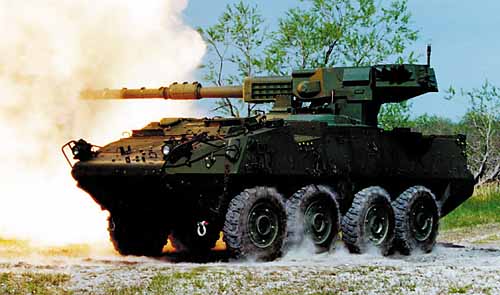

Less than a decade after 70-ton tanks stomped Saddam Hussein in Desert Storm, the mighty weapons that ended World War I, started World War II, and possibly prevented World War III are about to ride into military history. A bold, new effort to turn the U.S. Army into a rapid deployment force will require it to trade the plodding protection of the depleted-uranium armor for the mile-a-minute speed and off-road agility of light armored vehicles (LAV). This doesn't mean the Army is about to leave big guns behind. The heavy hitter in the Army's new Interim Brigade Combat Teams (IBCT) will sport a modernized version of the 105mm cannon, the original gun on the Abrams M1 main battle tank.
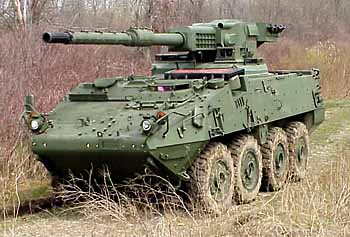
Some generals recognized the limitation of tanks during the first hours of the Yom Kippur War in 1973. Egyptian combat teams equipped with Soviet-made shoulder-fired missiles destroyed 165 of Israel's 265 first-echelon tanks, quickly disproving the maxim that it takes a tank to kill a tank. A quarter century later, NATO's experience in Kosovo sealed the issue for any laggers. While U.S. Apache helicopters, set to attack tanks, eventually got to their staging area in Albania, American tanks were a no-show. The Abrams tanks that in 1991 brought the Persian Gulf War to a close in 100 hours had, for the most part, traveled to the Mideast by boat. In Kosovo, however, these 70-ton tanks were too heavy to arrive in time. During airlifts, only one can fit inside a C-5 or C-17 at a time.
Even if Abrams tanks had been prepositioned, military strategists say, it is questionable if their presence would have made much of a difference in the outcome of the conflict. Fighting in Eastern European cities is as different from open desert warfare as it gets. The heavy armor that made the Abrams so formidable a deterrent against a Soviet tank invasion of Western Europe during the Cold War years had become a strategic liability. The size of the tanks was more than could be handled by the crumbling infrastructure linking the remains of what had been Yugoslavia. For Pentagon planners, the truth was inescapable. The U.S. Army, the world's only deployable army, was in effect muscle-bound. Its most powerful land weapon was too big to get to a fight.
As startling as the Army's transformation program would be, the speed with which this change would take place would be greater. "We will begin to immediately transform the entire Army into a more dominant and strategically responsive force," says Gen. Eric K. Shinseki, chief of staff of the Army. To accomplish this, Shinseki ordered that the new IBCT be equipped with off-the-shelf hardware. And so, a mere 10 weeks after the announcement of the Army's reorganization, POPULAR MECHANICS is standing on the frosty Baum Firing Range at the U.S. Army Armor Center at Fort Knox, Ky. We have been invited to watch the Pentagon's "platform performance demonstration (PPD)," a head-to-head test of 35 combat vehicles from seven countries.
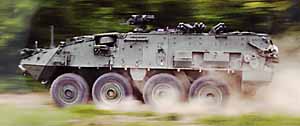
The basic vehicle is a 19-ton, Canadian-built LAV III that rides on run-flat tires. Weapons, ammunition and crew double its weight. Full-time four-wheel drive with selective eight-wheel drive enables it to speed at 60 mph on the open road, traveling 312 miles before refueling. It is fully protected with 14.5mm armor that, the Army claims, is sufficient to keep machine gun bullets and mortar and artillery fragments from injuring its two-man crew.
Once in a combat zone, the vehicles will be expected to operate independently for 72 hours.
"Since all the vehicles possess the same characteristics, whether it's cross-country or on the highway, they move as a fighting unit and retain that cohesiveness," explains Lt. Gen. Paul Kern, head of Army acquisitions.
The initial order for 366 vehicles includes specialized versions for reconnaissance, fire support, medical evacuation and engineering teams. Other models will be equipped to fire mortars and missiles. Command vehicles and nuclear, chemical and bioweapons detection vehicles round out the package.
As now conceived, an Interim Armored Vehicle Company will use 20 LAVs. A dozen will carry nine infantrymen in each. A pair of vehicles will each have 60mm to 120mm mortars, another will have a remote control gun for fire suppression. There are two command vehicles.
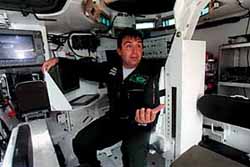
Automated navigation and weapons systems will let the crew fire at targets from the safety of the vehicle�s protective armor, an important consideration in urban warfare. Photo by the Windsor Star.
The remaining three vehicles, designated the Mobile Gun System Variant, will carry the company's biggest weapon, a 105mm rifled cannon mounted in a low-profile turret. This is the same firepower originally installed on the first generation of Abrams M1 battle tanks.
The initial reaction of tank commanders has been to downplay the abilities of these new weapons. And, the wheel versus tread debate is still very much alive, with the Pentagon's decision being challenged by a track vehicle manufacturer. Congress also has stepped in and ordered a test to determine which is superior.
But the future of tanks may already be foretold in the headlines of the world press. Today, wars are small regional conflicts that increasingly start and end fast. A weapon that can't arrive in time for the battle isn't really a weapon at all. --S.G.
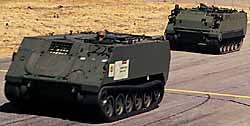
Just as the cavalry gave way to internal-combustion chariots, Army planners are poised to take the next evolutionary step in tactical mobility technology: They are going electric.
Hybrid electric propulsion, already available in some commercial vehicles, is now being considered for use on combat vehicle platforms.
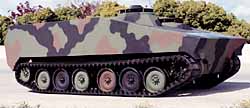
In an impromptu drag race (top), the electric hybrid beat the IC engine. Band tracks (above) reduce noise to stealth levels.
United Defense L.P., for example, has developed a hybrid electric-drive demonstrator based on its tracked M113 armored personnel carrier.
The hybrid's major components include a diesel-powered, engine-driven generator, a battery pack for power storage, and two 250-hp oil-cooled electric motors used to drive the track sprockets.
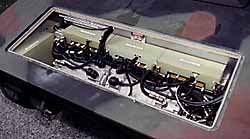 During normal operations, vehicle power is provided simultaneously from both the battery pack and the generator. The system design allows the prime generator to provide the power necessary to drive track sprockets and auxiliary equipment, with the batteries providing supplemental power for accelerating or hill climbing. Since electric motors act like generators, the system also recovers and stores power during vehicle braking.
During normal operations, vehicle power is provided simultaneously from both the battery pack and the generator. The system design allows the prime generator to provide the power necessary to drive track sprockets and auxiliary equipment, with the batteries providing supplemental power for accelerating or hill climbing. Since electric motors act like generators, the system also recovers and stores power during vehicle braking.
The hybrid engine provides 500 hp and more than enough acceleration to leave most internal-combustion (IC) tactical vehicles in the dust.